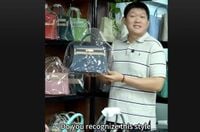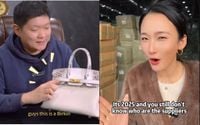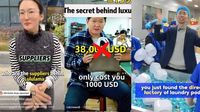In the midst of a heated trade war between the United States and China, a wave of TikTok videos from Chinese manufacturers has taken the internet by storm, revealing the surprising truth behind the luxury products that many consumers believe are crafted in the West. As tariffs escalate, these creators are not only exposing the origins of high-end items but also encouraging consumers to bypass traditional retail channels and purchase directly from factories.
On April 12, 2025, China implemented a staggering 125% tariff on American imports, a retaliatory measure following President Trump's threats of a 145% tariff increase on Chinese goods. This dramatic shift in trade dynamics has sparked an online frenzy, with Chinese manufacturers leveraging platforms like TikTok to showcase how luxury brands such as Gucci, Prada, and Louis Vuitton are produced in China at a fraction of the retail price.
One viral video features a Chinese OEM factory owner claiming, "For more than the last 30 years, we have been the OEM factory for most of the luxury brands from around the world. You name it…. But for this, I am not proud because we were only making our wages, and the profit margin for those who are actually making the bags is very low.” This statement has resonated with viewers, prompting them to reconsider the value attributed to luxury goods.
As the TikTok trend unfolds, the narrative is clear: many luxury items marketed as "Made in USA" are actually manufactured in China. The revelations have led to a surge of interest in the grey market, where consumers can purchase these goods directly from the source, often at significantly reduced prices. One user on the platform remarked, "How can they charge $500 for a bag that costs $30 to make here?" This sentiment reflects a growing awareness among consumers about the disparity between production costs and retail prices.
In another eye-opening clip, a user demonstrated that a Hermès Birkin bag, typically retailing for around $38,000, can be produced for as little as $1,000. This stark contrast has fueled discussions about the ethics of luxury pricing and the role of branding in consumer perception. The creator noted, "The only difference between what’s sold directly and what ends up on shelves is the branding."
As the trade war intensifies, China has called for the cancellation of what it describes as the "unfair practice of reciprocal tariffs." The Ministry of Commerce stated, "We urge the US to take a big step to correct its mistakes, completely cancel the wrong practice of ‘reciprocal tariffs’ and return to the right path of mutual respect.” This diplomatic overture comes amidst rising tensions and a push for transparency in the global supply chain.
In addition to exposing the manufacturing practices of luxury brands, TikTok videos have also highlighted the potential for counterfeit goods. With the Chinese government reportedly easing restrictions on counterfeit production, some creators are openly promoting alternatives to expensive luxury items. One TikTok user stated, "Don’t waste your money anymore. Here it’s factory price," encouraging viewers to purchase directly from manufacturers.
This trend has sparked a mix of reactions from consumers. Some express excitement at the prospect of acquiring high-end items for less, while others voice concerns about quality and ethics. One user commented, "I’m torn on this TikTok drama exposing luxury brands. It’s wild seeing Chinese factories reveal how they make Gucci bags for pennies, then we pay thousands here.” This duality in consumer sentiment underscores the complexities of luxury branding in a globalized economy.
Amid the chaos of the trade war, major American tech companies have found some relief. The Trump administration recently announced exemptions for certain electronic products from import tariffs, benefiting firms like Apple, Nvidia, and Dell. These exemptions, however, do not extend to the luxury goods sector, which continues to grapple with rising costs and shifting consumer behaviors.
In a related development, Canadian investor Kevin O’Leary recently voiced support for Trump’s tariffs, controversially suggesting that the U.S. should "train Beijing like a puppy." This statement reflects a broader sentiment among some American business leaders who believe that tariffs are necessary to protect domestic industries. However, as the luxury market faces increasing scrutiny, it remains to be seen how these dynamics will evolve.
As the TikTok revelations gain traction, they are challenging the traditional narrative of luxury branding. Many consumers are beginning to see luxury brands as "high-markup middlemen" rather than genuine producers of superior quality. This shift in perception could have lasting implications for the global luxury market, which has already seen a decline in sales, particularly among younger consumers who prioritize experiences over material possessions.
While the trade war rages on, the exposure of luxury brand supply chains is prompting a reevaluation of consumer values. As more individuals question the worth of luxury goods, the potential for a new kind of nationalism is emerging in China, with consumers increasingly favoring local brands that offer similar quality at lower prices.
As the conversation continues, it is clear that the intersection of social media, trade policy, and consumer behavior is reshaping the landscape of luxury goods. Whether this trend will lead to a fundamental shift in how luxury is perceived and consumed remains to be seen, but one thing is certain: the curtain has been pulled back, and the magic behind luxury branding is being scrutinized like never before.







